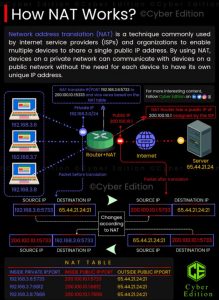Network Address Translation (NAT) is a technique used to modify network address information in packet headers while in transit across a traffic routing device. In simple terms, NAT allows multiple devices on a local network to share a single public IP address when accessing the internet. Here’s a basic explanation of how NAT works, particularly in the context of Microsoft Windows:
- Private and Public IP Addresses: Devices on a local network (like your home or office) use private IP addresses (e.g., 192.168.1.x). These addresses are not routable on the internet. NAT translates these private IP addresses to a public IP address that can be used on the internet.
 Outbound Traffic: When a device on the local network sends a request to the internet (e.g., visiting a website), the NAT device (often a router) replaces the private IP address in the packet’s header with its own public IP address. It also keeps track of this translation in a NAT table.
Outbound Traffic: When a device on the local network sends a request to the internet (e.g., visiting a website), the NAT device (often a router) replaces the private IP address in the packet’s header with its own public IP address. It also keeps track of this translation in a NAT table.- Inb
- ound Traffic: When the response comes back from the internet, the NAT device uses the NAT table to determine which private IP address the response should be forwarded to. It then replaces the public IP address in the packet’s header with the appropriate private IP address and sends the packet to the correct device on the local network.
- Port Address Translation (PAT): A common form of NAT, PAT also uses unique port numbers to distinguish between different sessions originating from the same IP address. This allows multiple devices to share a single public IP address simultaneously.
In a Microsoft environment, NAT can be configured using Windows Server with the Routing and Remote Access Service (RRAS) or through network devices like routers and firewalls that support NAT. This setup helps in conserving public IP addresses and adds a layer of security by hiding internal IP addresses from the external network.